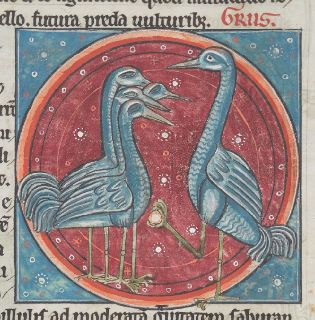Crane
| Latin name: | Grus |
| Other names: | Grua, Grue, Grues, Gruve, Zherav |
| Category: | Bird |
At night cranes take turns keeping watch for enemies
General Attributes
Cranes fly in order, with the leader guiding the flock with a shrill voice; when the leader becomes tired or his voice gives out, another takes his place. They fly high in the air so they can see the lands they seek. If the wind is strong cranes swallow sand or carry stones for ballast. At night cranes take turns keeping watch for enemies. The one who is on duty holds a stone up with one claw; if the watcher falls asleep the stone will fall and wake him. Cranes are the enemy of pygmies, with whom they are constantly at war.
Allegory/Moral
The sentinel cranes represent those who provide goods for others in common, and watch over the obedience of their brothers, protecting them from devils and the incursions of this world. The stone held in the claw is Christ; the claw, the disposition of the mind, so that the one who stands guard over himself or others should carry the stone of Christ in his mind. If such a man falls asleep in sin, Christ the stone will fall from his mind. Then he must cry out by means of confession. The change of color in old age refers to the elderly when they repent of their sins.
Illustration
Illustrations of cranes usually show them with a characteristic red cap. The scene of the crane standing guard with a stone in its claw is the one most commonly illustrated; the war of the cranes and the pygmies is occasionally shown.
Uses Magical, Medical, Alchemical and Culinary
Hildegard von Bingen says: "If a pestilence is troubling and killing pigs, pulverize the bill of a crane, and give this powder to them to eat in a mush, or to drink in water. They will be better, and the pestilence will go from them." (Throop translation)


